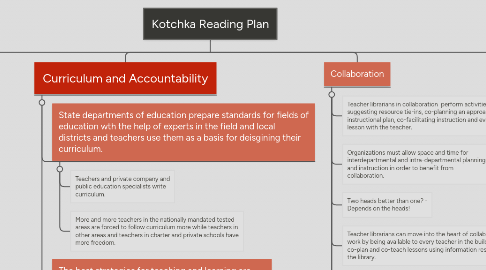
1. Educational Theory and Practice
1.1. Behaviorist approach is more scripted and constructivist draws more form the learner's experience.
1.1.1. Differentiated Instruction presents instruction in different ways to different learners depending on their needs and strengths.
1.1.1.1. Standards-based education starts planning for instruction from state or national standards and offers a "checklist' mentality of coverage.
1.2. Blended learning like flipped classrooms shifts some of the learning to the student's home-based efforts mainly through digital or online preparation
1.2.1. The U.S. government ties federal funding for education to states' willingness to follow national assessment guidelines and national standards.
1.2.2. Inquiry based or project based learning leads students through a process where they are posing and answering questions for themselves as a way of learning with essential questions as a guide.
1.3. Multiple intelligences refer to various ways of being intelligent that people have such as linguistic, logical, musical, etc. that explain why people are quicker to learn at some things more than others.
1.3.1. SAMR Model of technology shows a continuum of technology integration from technology substituting for another tool with no real change to redefinition where technology allows for new, previously inconceivable tasks.
1.3.2. Employee
2. 21st Century Skills and Information Literacy
2.1. ii
2.1.1. 21st Century Skills are skills that students will need to survive in this century such as critical thinking, collaboration, information literacy, technology skills, leadership, media literacy, etc.
2.1.1.1. The Partnership for 21st Century Learning is a consortium of business, education and government organizations that work together to ensure that students will have access to learning 21st century skills.
2.1.1.2. Information literacy is the ability to formulate an information search and locate, evaluate and use information from a variety of sources.
2.1.1.2.1. Inquiry is a model of discovery learning that starts with a question and follows that question along a path of discovery
2.1.1.2.2. The difference between these three above is that 21st Century Skills are more all-encompassing and information literacy is one of those skills. inquiry is one approach to learning those skills.
3. Curriculum and Accountability
3.1. State departments of education prepare standards for fields of education wth the help of experts in the field and local districts and teachers use them as a basis for deisgining their curriculum.
3.1.1. Teachers and private company and public education specialists write curriculum.
3.1.2. More and more teachers in the nationally mandated tested areas are forced to follow curriculum more while teachers in other areas and teachers in charter and private schools have more freedom.
3.2. The best strategies for teaching and learning are those that give students experiences similar to real-life and are scaffolded in steps to help students succeed.
3.2.1. We can learn if a student has learned the material by assessing both formally through teacher made and standardized tests and informally through exit tickets, quickwrites, projects, real-life tasks, student peer teaching, etc.
3.2.2. The Common Core State Standards affect what is taught and what is assessed because they ask students to think at a more critical level so they are asked to delve deeper into texts and find evidence for their claims. However the assessments are narrowed to reading and math because those are the areas for which the standards exist.
3.2.3. Race to the Top is standardizing the types of assessment that are given throughout the US and increasing the frequency of mandated testing.
